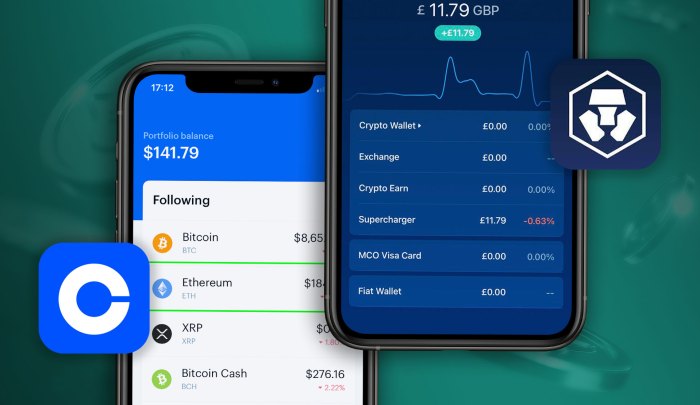Interested in delving into the world of crypto apps? Look no further as we explore the ins and outs of these digital tools that have taken the financial realm by storm.
From their purpose to security measures, we’ve got you covered with all the essential information you need to know.
Overview of Crypto Apps
Crypto apps are applications designed to facilitate the buying, selling, and trading of cryptocurrencies. They provide a platform for users to manage their digital assets securely and efficiently in the digital world. These apps have gained popularity in recent years due to the increasing interest in cryptocurrencies as an alternative investment and the growing adoption of blockchain technology.
Examples of Popular Crypto Apps
- Coinbase: One of the most widely used crypto apps, Coinbase allows users to buy, sell, and store a variety of cryptocurrencies. It offers a user-friendly interface and secure storage options.
- Binance: Known for its extensive range of cryptocurrencies available for trading, Binance is a popular choice for experienced traders. It also offers advanced trading features and a mobile app for on-the-go trading.
- Robinhood: While primarily a stock trading app, Robinhood also allows users to invest in cryptocurrencies commission-free. It is known for its simplicity and accessibility to beginner investors.
Types of Crypto Apps

Cryptocurrency apps come in various forms to cater to different needs within the crypto ecosystem. Understanding the distinctions between cryptocurrency wallets, exchanges, investment apps, decentralized finance (DeFi) apps, and crypto mining apps is crucial for navigating this rapidly evolving industry.
Cryptocurrency Wallets
Cryptocurrency wallets are essential tools for securely storing and managing digital assets. They come in two main types: hot wallets (connected to the internet) and cold wallets (offline storage). Some popular wallet options include hardware wallets like Ledger Nano S, software wallets like Exodus, and mobile wallets like Trust Wallet.
Cryptocurrency Exchanges
Cryptocurrency exchanges are platforms where users can buy, sell, and trade various digital assets. They act as intermediaries connecting buyers and sellers and facilitate the exchange of cryptocurrencies for fiat currencies. Examples of popular exchanges include Coinbase, Binance, and Kraken.
Investment Apps
Investment apps allow users to invest in cryptocurrencies and manage their portfolios. These apps often provide tools for tracking market trends, setting up automated investments, and accessing educational resources. Apps like Robinhood, eToro, and Gemini are well-known in this space.
Decentralized Finance (DeFi) Apps
Decentralized Finance (DeFi) apps aim to recreate traditional financial services like lending, borrowing, and trading on blockchain networks without the need for intermediaries. They operate on smart contracts and offer increased transparency, security, and accessibility. Platforms like Uniswap, Compound, and Aave are popular DeFi apps.
Crypto Mining Apps
Crypto mining apps allow users to participate in the process of validating transactions on a blockchain network and earning rewards in the form of newly minted cryptocurrencies. These apps leverage computational power to solve complex algorithms and secure the network. Popular mining apps include NiceHash, Cudo Miner, and Honeyminer.
Security Measures in Crypto Apps
When it comes to using crypto apps, security is a top priority. With the growing popularity of cryptocurrencies, it is essential to understand the common security risks associated with using crypto apps and the measures taken to protect user assets.
Common Security Risks
- Phishing attacks: Hackers may create fake websites or emails that mimic legitimate crypto apps to steal users’ login credentials or private keys.
- Malware: Malicious software can infect devices and steal sensitive information, such as passwords or wallet keys.
- Exchange hacks: Centralized exchanges are vulnerable to cyber attacks, leading to the loss of user funds.
- Social engineering: Scammers may trick users into revealing their private keys or sending funds to fraudulent addresses.
Security Features in Reputable Crypto Apps
- Two-factor authentication (2FA): Adds an extra layer of security by requiring users to provide a second form of verification, such as a code from a mobile app.
- End-to-end encryption: Ensures that data is encrypted from the sender to the recipient, preventing unauthorized access.
- Multi-signature wallets: Require multiple private keys to authorize transactions, reducing the risk of unauthorized transfers.
- Cold storage: Storing a significant portion of funds offline in hardware wallets to prevent hacking attempts.
Tips for Enhanced Security
- Use strong, unique passwords for each crypto app account and enable 2FA whenever possible.
- Avoid clicking on suspicious links or emails and always double-check the URL before entering sensitive information.
- Regularly update your devices and crypto apps to patch any security vulnerabilities.
- Backup your wallet keys securely and never share them with anyone.
User Experience in Crypto Apps

User experience plays a crucial role in the success of crypto apps, as it determines how easily users can navigate through the app, make transactions, and manage their digital assets. A user-friendly interface can enhance the overall experience and encourage more people to adopt crypto technology.
Importance of User-Friendly Interfaces
User-friendly interfaces are essential in crypto apps to ensure that users can easily access and use the features of the app without facing any challenges. A well-designed interface with intuitive navigation can make it easier for users to send and receive cryptocurrencies, track their transactions, and manage their digital wallets effectively.
Comparison of Transaction Speed and Fees
Different crypto apps may vary in terms of transaction speed and fees charged for transactions. It is important for users to compare these factors when choosing a crypto app to ensure that they are getting the best value for their transactions. Some apps may offer faster transaction speeds but charge higher fees, while others may have lower fees but slower transaction times.
Users should consider their priorities and needs when selecting a crypto app based on transaction speed and fees.
Best Practices for Navigating and Using Crypto Apps
- Secure your account with a strong password and enable two-factor authentication for added security.
- Regularly update the app to access new features and security enhancements.
- Verify the recipient’s wallet address before sending any cryptocurrency to prevent sending funds to the wrong address.
- Keep track of your transactions and monitor your digital assets regularly to detect any unauthorized activity.
- Familiarize yourself with the app’s interface and features to make the most of its capabilities and functionality.
Last Point
As we wrap up our discussion on crypto apps, it’s evident that these innovative tools are here to stay, revolutionizing the way we interact with digital currencies. Whether you’re a seasoned user or a newbie, mastering the art of crypto apps is key to staying ahead in the ever-evolving financial landscape.